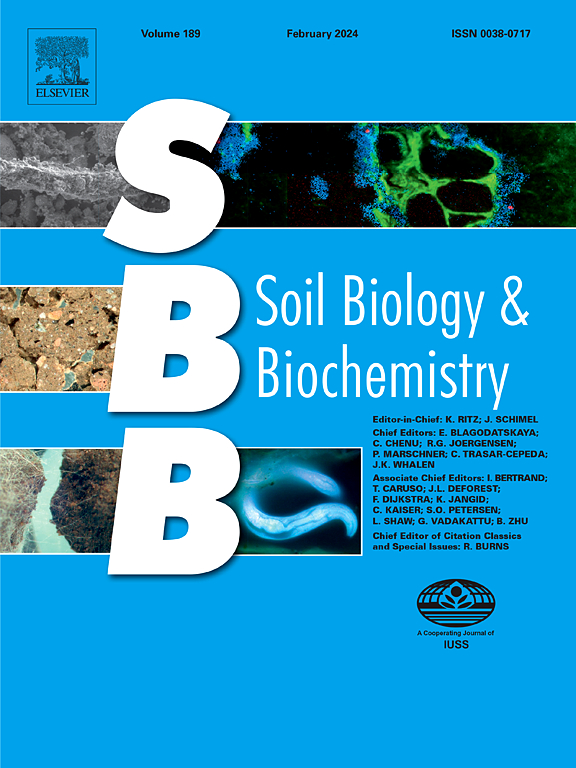Microbial scents: Soil microbial Volatile Organic Compounds (mVOCs) as biomarkers for grasslands across a land use gradient
IF 9.8
1区 农林科学
Q1 SOIL SCIENCE
引用次数: 0
Abstract
Extensifying land use practices – i.e. decreasing management intensity – is pivotal to facilitate the transition towards sustainable agriculture in productive grasslands, as it promotes the enhancement of soil biotic communities that support important ecosystem services. To monitor these transitions effectively, improved inventories are needed to track changes in microbial communities. Microbial Volatile Organic Compounds (mVOCs) are potential biomarkers that can link soil community change to land use extensification (i.e. reducing land use intensity) and may provide important information on changes in soil processes in transitional productive grasslands. We investigated how land use extensification affects mVOC profiles in grassland soils through both abiotic and biotic factors and whether mVOCs can be linked to bacterial (16S) and fungal (ITS2) community composition. We measured mVOCs (GC-MS), microbial communities, and abiotic soil parameters (SOM, SOC, pH, bulk density, and nutrients) across eighteen grasslands with varying land use intensity. A total of 75 mVOCs were identified using the mVOC 4.0 library. Furthermore, we show that mVOC profiles and chemical classes differ across land use types – conventional, extensive, and semi-natural grasslands. Within these grasslands, only fungi showed distinct community compositions between land use intensity types, whereas there were no compositional differences of bacteria. Using Taxon Indicator Threshold Analysis (TITAN), we identified sixteen mVOC compounds that varied significantly along a land use intensification gradient. These findings suggest that mVOCs can serve as biomarkers linking changes in land use intensity and soil microbial communities, although these relationships are complex in field conditions. We identified a set of mVOCs tied to changes in land-use extensification and highlighted their potential as indicators of soil microbial community turnover. mVOCs offer a valuable tool for monitoring land use transitions, and our results emphasize their role in integrating microbial community metrics and soil health indicators into land management strategies.
微生物气味:土壤微生物挥发性有机化合物(mVOCs)作为草原跨土地利用梯度的生物标志物
扩大土地利用实践——即降低管理强度——对于促进向生产性草原的可持续农业过渡至关重要,因为它促进了支持重要生态系统服务的土壤生物群落的增强。为了有效地监测这些转变,需要改进库存来跟踪微生物群落的变化。微生物挥发性有机化合物(mVOCs)是一种潜在的生物标志物,可以将土壤群落变化与土地利用扩展(即降低土地利用强度)联系起来,并可能提供过渡性生产性草地土壤过程变化的重要信息。我们研究了土地利用扩展如何通过非生物和生物因素影响草地土壤中mVOC的分布,以及mVOC是否与细菌(16S)和真菌(ITS2)群落组成有关。我们测量了18个不同土地利用强度草原的mVOCs (GC-MS)、微生物群落和非生物土壤参数(SOM、SOC、pH、体积密度和养分)。使用mVOC 4.0库共鉴定了75种mVOC。此外,我们还表明,不同土地利用类型(传统、粗放型和半自然草地)的mVOC分布和化学类别存在差异。在不同的土地利用强度类型间,只有真菌的群落组成存在差异,而细菌的群落组成没有差异。通过分类单元指标阈值分析(TITAN),我们确定了16种mVOC化合物在土地利用集约化梯度上存在显著差异。这些发现表明,mVOCs可以作为联系土地利用强度变化和土壤微生物群落的生物标志物,尽管这些关系在田间条件下是复杂的。我们确定了一组与土地利用扩展变化相关的mVOCs,并强调了它们作为土壤微生物群落更替指标的潜力。mVOCs为监测土地利用转变提供了有价值的工具,我们的研究结果强调了它们在将微生物群落指标和土壤健康指标整合到土地管理战略中的作用。
本文章由计算机程序翻译,如有差异,请以英文原文为准。
求助全文
约1分钟内获得全文
求助全文
来源期刊

Soil Biology & Biochemistry
农林科学-土壤科学
CiteScore
16.90
自引率
9.30%
发文量
312
审稿时长
49 days
期刊介绍:
Soil Biology & Biochemistry publishes original research articles of international significance focusing on biological processes in soil and their applications to soil and environmental quality. Major topics include the ecology and biochemical processes of soil organisms, their effects on the environment, and interactions with plants. The journal also welcomes state-of-the-art reviews and discussions on contemporary research in soil biology and biochemistry.
 求助内容:
求助内容: 应助结果提醒方式:
应助结果提醒方式:


